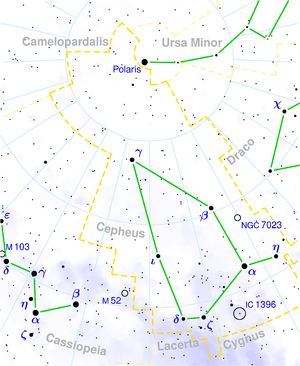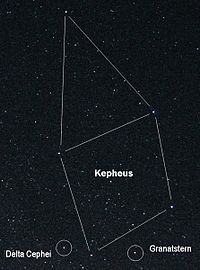Cepheus (constellation)
|
Cepheus constellation |
|
|---|---|
| Latin name | Cepheus |
| Latin genitive | Cephei |
| Abbreviation | Cep |
| Right ascension | 20 h 01 m 56 s to 09 h 03 m 20 s |
| declination | + 53 ° 21 ′ 12 ″ to + 88 ° 41 ′ 46 ″ |
| surface | 587,787 deg² rank 27 |
| Completely visible | 90 ° N to 0.3 ° N |
| Observation time for Central Europe | All year round |
| Number of stars brighter than 3 mag | 1 |
| Brightest star (size) | Alderamine (2.45) |
| Meteor streams |
no |
|
Neighboring constellations ( clockwise from north ) |
|
| swell | IAU , |
 From the Uranometria by Johann Bayer . |
|
The Kepheus ( latin Cepheus ) is a constellation of the northern sky.
description
The Cepheus is not as distinctive as the constellations Cassiopeia and Dragon . Its brightest stars are reminiscent of a house with a pointed roof. From Central Europe, Cepheus is visible all year round ( i.e. circumpolar ).
Due to the precession , the celestial north pole will be in the constellation of Cepheus in about 3000 years.
mythology
According to Greek mythology, Cepheus was the king of Ethiopia , consort of Cassiopeia and father of Andromeda . His wife drew the wrath of the gods because she claimed to be even more beautiful than the Nereids , the daughters of the sea god Nereus . The Nereids so reviled turned to the sea god Poseidon and demanded the punishment of the vain Cassiopeia. Poseidon then sent a sea monster to plague the shores of Cepheus' realm. The only way to appease the beast was to sacrifice Andromeda to it. Andromeda awaited her horrible fate chained to a rock, but was saved at the last moment by the hero Perseus , who got her as a wife as a reward.
Cepheus, Kassiopeia , Andromeda , Perseus and the monster Ketos were immortalized as constellations in the sky. The latter in the shape of the constellation whale (Cetus).
Celestial objects
Stars
| B. | F. | Names or other designations | size | Lj | Spectral class |
|---|---|---|---|---|---|
| α | 5 | Alderamin | 2.45 | 49 | A7 IV-V |
| β | 8th | Alfirk | 3.15 to 3.21 | about 700 | B2 III |
| γ | 35 | Errai , Arrai, Alrari | 3.22 | 46 | K1 IV |
| ζ | 21st | Tsao Fu | 3.39 | 726.43 | K1 Ib |
| η | 3 | Eta Cephei | 3.40 | 46.78 | K0 IV |
| ι | 32 | Iota Cephei | 3.50 | 115.38 | K1 III |
| δ | 27 | Al Radif, Delta Cephei | 3.6 to 4.3 | 950.92 | F5 to G3 Ib |
| μ | Garnet Star , Erakis | 3.62 to 5.0 | 5260.73 | M2 Iab + M0 + A | |
| ε | 23 | Phicares | 4.18 | 83.93 | F0 IV |
| θ | 2 | Al Kidr | 4.20 | 135.68 | A7 III |
| ν | 10 | Cor Regis | 4.25 | 5096.36 | A2 Ia |
| ξ | 17th | Alkurah , Kurah | 4.26 | 85.83 | A3 + F7 |
| κ | 1 | 4.38 | 327.15 | B9 III | |
| π | 33 | 4.40 | 219.94 | G3 + F3 | |
| υ 1 | 4.52 | ||||
| 11 | 4.54 | 175.83 | K0 III | ||
| ο | 34 | 4.75 | 210.70 | K0 III + F6 | |
| 9 | 4.76 | 4530.13 | B2 Ib | ||
| 24 | 4.79 | 377.51 | G8 III | ||
| VV Cephei | 4.91 to 5.18 | 8363.23 | M2 Iab + B6 IIe | ||
| 16 | 5.04 | 122.30 | F5 V | ||
| λ | 22nd | 5.05 | 1647.31 | O6 Iab | |
| ρ 2 | 29 | Al Kalb al Rai | 5.5 | 245 | A3 V |
| 19th | 5.07 | 5436.23 | O9 Ib | ||
| 31 | 5.08 | 184.28 | F3 III | ||
| 30th | 5.18 | 319.77 | A3 IV | ||
| 6th | 5.19 | 1080.00 | B3 IV | ||
| 18th | 5.26 | 448.65 | M5 III | ||
| 20th | 5.27 | 318.21 | K4 III | ||
| 7th | 5.42 | 771.08 | B7 V |
Alpha Cephei , the brightest star in Cepheus, is about 49 light years away. It is a whitish-yellowish shining star that is about the size of our sun.
The name Alderamin is of Arabic origin and means "the right arm".
Double stars
| system | Sizes | distance |
|---|---|---|
| β | 3.2 / 7.8 | 13.3 " |
| ζ | 4.5 / 6.5 | 8.1 " |
| δ | 3.4 / 6.3 | 41.0 " |
| µ | 3.62-5.0 / 12.3 | 4.1 " |
| π | 4.6 / 6.6 | 1.2 " |
| 34 | 4.9 / 7.1 | 2.9 " |
| VV | 5.15 / 6.66 | 0 ", 0120 ± 0", 0011 |
The star Beta Cephei is a binary 230 light years away. The system can already be resolved into single stars in a smaller telescope .
The Arabic name Alfirk means "the flock".
Delta Cephei is a binary star 890 light years away. Due to the large angular distance of 41 arcseconds , the two components can already be seen in bright prism binoculars .
Beta Cephei and Delta Cephei are also variable stars .
Variable stars
| object | size | period | Type |
|---|---|---|---|
| β | 3.15 to 3.21 | 0.1904844 days | Beta Cephei star |
| δ | 3.6 to 4.2 | 5.3663 days | Cepheid |
| μ | 3.4 to 5.1 | approx. 730 days | semi-regular |
| ρ | 4.1 to 6.2 | 100 to 1000 days | semi-regular |
| T | 5.3 to 11.2 | 388.1 days | Mira star |
| VV | 4.91 to 5.18 | 7,430.5 days / 34 years | VV Cephei ( variable coverage , semi-regular) |
| EE | 10.72 to 12.15 | 5.61 years | unusual occultation changeable |
Beta Cephei is the namesake of a group of variable stars , the Beta Cephei stars . They are pulsation-variable stars with brief fluctuations in brightness of 2 to 14 hours. β Cephei is about 230 light years away.
Delta Cephei is also the namesake of an important group of changeable people, the Delta Cepheids . These are giant stars with high luminosity that go through an unstable stage. They inflate and contract again at regular intervals. This pulsation can be perceived as a regular change in brightness. The luminosity and the pulsation duration are directly related. The more luminous the star, the slower it pulsates. Delta Cepheids can thus be used to determine the distance of star clusters and galaxies .
The star My Cephei was designed by the astronomer William Herschel because of its deep red color Garnet Star called. It is a red supergiant with 60,000 times the luminosity of our sun . Its diameter is estimated to be 1450 times the solar diameter.
This enormous value is even exceeded by the supergiant VV Cephei A. If placed in our solar system, the star would reach up to the orbit of the planet Saturn . The apparent brightness of the double star system VV Cephei decreases by about 20 percent when the less luminous companion is behind the main star.
The orange hypergiant RW Cephei is very massive . However, the semi-regular star with an apparent magnitude of +6.65 mag is no longer visible to the naked eye.
NGC objects
| NGC | other | size | Type | Surname |
|---|---|---|---|---|
| 188 | 8.1 | Open star cluster | ||
| 6946 | 11 | Galaxy | ||
| 6939 | 9 | Open star cluster | ||
| 7023 | 7th | Open star cluster | ||
| 7235 | 7th | Open star cluster | ||
| 7380 | 7th | Open star cluster | ||
| 7510 | 7th | Open star cluster | ||
| IC 1396 | 9 | Open star cluster |
IC 1396 is a star cluster 2000 light years away. The star cluster is embedded in an extensive emission nebula , which, however, only becomes visible in long-exposure photographs.
NGC 6946 is a Sc-type spiral galaxy 15 million light years away.



